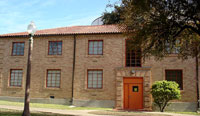Professor Calls For UT Dorm Named After KKK Organizer To Be Renamed

A former UT professor who has researched UT's less-than-proud past on race relations is reminding the world that Simkins Hall bears the name of a Ku Klux Klan organizer, but UT officials say they aren't sure renaming the aging dorm would be well advised.
After years of research, professor Thomas Russell now is pushing UT officials to remove Simkins's name from the dorm. The residence hall is named after William Stewart Simkins, who Russell says boasted of his past organizing the KKK in Florida while he was teaching law at Texas.
Russell himself taught law at UT for 10 years and now works at the University of Denver. During his decade in Austin, he started looking into Simkins, and last month he published a research paper on the subject.
Simkins Hall was commemorated in 1954. Situated along Waller Creek, it opened in 1955 as the campus's first air-conditioned men's building. It remains UT's only all-male hall, housing 190 young men.
Russell's call for its renaming has gotten attention locally and now nationally. Austin TV station KXAN reported it this week, and the Chronicle of Higher Education picked it up yesterday.
"It's simply not appropriate for The University of Texas administrators to continue to honor a Klansman by keeping his name on a dormitory," Russell told KXAN. "After the war, he participated in violence against blacks. And then while he was at the University, he used to give a speech honoring his own Klan past."
A bust of Simkins was removed from the hall years ago. But administrators are not rushing to make a name change that they told the news organizations would be costly, complicated, and ultimately moot.
Renaming the dorm could be a long and expensive process that would require approval from the Board of Regents, pointed out Gregory Vincent, UT's vice-president for diversity and community engagement. Simkins Hall is slated for eventual teardown, he added, and in the meantime, it's important to acknowledge the University's history in a forthright way.
"Through a process, with students and faculty, they recognized this particular person," Vincent said. "So the question is now, do we un-recongnize those individuals? I think what we need to be careful about is making sure we send the message that we need to be honest about our history."
Simkins, a Citadel graduate and Civil War veteran, was connected to many law school traditions, says Jim Nicar, the Texas Exes' UT history and traditions coordinator. For instance, the law school mascot Peregrinus was invented in his classroom.
According to Nicar's research, Simkins was an eccentric character with long hair and a colorful, effective teaching style. The hall was named after him because it was closer to the law school than other men's dorms and was designed to house law students.
Renaming buildings becomes a vexing question because figures from the past were products of their times and may have held views that are incompatible with modern values, Nicar says. Gov. Oran Roberts, who signed UT into existence and is the namesake of Roberts Hall, chaired the secession commission that led Texas out of the Union during the Civil War, he notes. Even George Washington, whose statue is on campus, owned slaves.
"At what point do we draw the line?" Nicar asks. "While none of us today would agree with or condone Simkins's involvement with the Klan, Russell's article is full of what historians call 'present-ism,' judging persons of the past by present-day values. I certainly wouldn't want a Simkins on the faculty today, but I understand that he was a product of his time as we are of ours."





